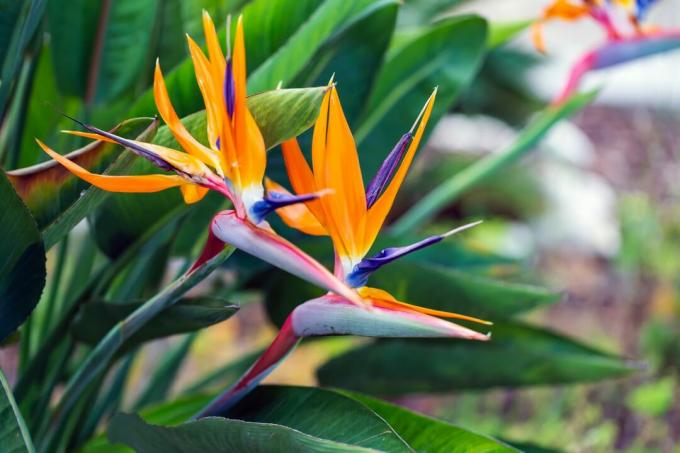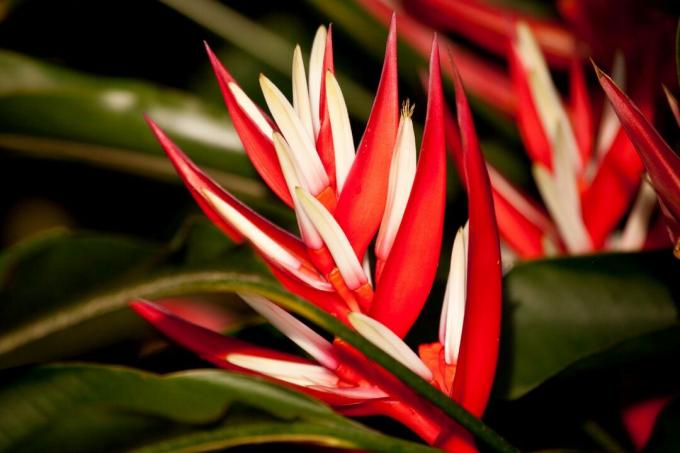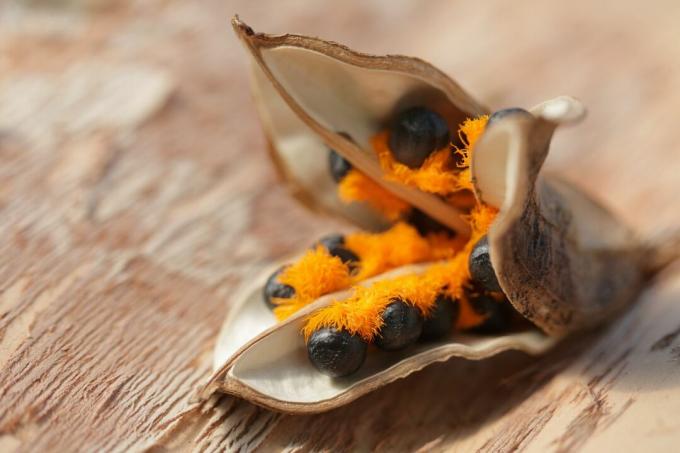The bird of paradise flower has a reason for its name. The flowers are reminiscent of colorful bird heads and are often used as cut flowers.

But the parrot flowers (Strelitzia reginae) are kept in the apartment. In the right location, the plants bloom all year round and can easily be propagated. Here you can find out what a suitable location looks like and how you can multiply the bird of paradise flower.
contents
- Strelitzia: flower, origin and properties
- The most beautiful types and varieties
- Planting Strelitzia: location, soil and procedure
- Propagating bird of paradise flower
- Is the Strelitzia poisonous?
Strelitzia: flower, origin and properties
Strelitzia is a genus of plants (Strelitzia), which includes five species. Their natural range is in southern Africa. The herbaceous, clump-forming plants can either grow tree-like or form no trunk at all. The king stiletto or bird of paradise flower (Strelitzia reginae) can also be kept as a houseplant and is very popular because of its flowers. The inflorescence is surrounded by a bract that tapers to a point and resembles a bird's beak. In its natural habitat, it serves as a perch for sunbirds, so to speak, which also pollinate the plant. With the colorful flowers protruding from it, the inflorescence is reminiscent of an exotic bird. Hence the bird of paradise flower, also known as the parrot flower, probably has its name.
While the Strelitzia- Flowering in nature extends from December to May, the bird-of-paradise flower has a flowering period from April to June in our country. A good location is also a year-round Strelitzia-Bloom possible. The first flowers appear on a Strelitzia at the age of three to six years. The leaves are oblong, can grow up to 50 cm long and look similar to the leaves of banana plants. Both belong to the same plant order, the gingers (Zingiberales). With 80 to 200 cm, the parrot flower reaches an impressive size.

Tip:Strelitzia reginae was named in honor of the British Queen Sophie Charlotte of Mecklenburg-Strelitz. The Latin word reginae means queen.
Which plants look similar to the parrot flower? There are other plants that are sometimes referred to as bird of paradise flowers and look quite similar to the parrot flower. The false bird of paradise flower (Heliconia angusta) also forms exotic, colorful flowers. Due to the similar-looking leaves, banana plants (Musa) Danger of confusion.
The most beautiful types and varieties
In addition to the Queen Strelitzia, there are four others Strelitzia-Species that can only be kept in large greenhouses in our latitudes. There are also two varieties of the bird of paradise flower in different colours:
- 'Mandela's Gold': The bird of paradise flower forms golden yellow flowers in this variety.
- Strelitzia reginae ‘Red Hot Flame’: This strain looks very similar to 'Mandela's Gold', however the bud base is the same Strelitzia colored bright red.

Planting Strelitzia: location, soil and procedure
For the bird of paradise flower, the location should be warm at around 20 - 25 °C. One thing is particularly important for the Strelitzia: light! It can hardly be bright enough for her. She likes to stand in the conservatory or at the south-facing window and also likes direct sunlight. If it is in the shade, it forms little or no flowers. After the ice saints in May, you can and should put the Strelitzia outside without any problems, because the sunlight is much stronger outside window panes. In order to gradually get the plant used to its surroundings, first place it in semi-shade and later move it to a sunnier spot. Since the Strelitzia is not hardy, it must not be planted directly outside, but should be in the bucket. When it gets colder at night in September, bring the parrot flower back inside. The Strelitzia does not tolerate temperatures below 3 °C well and weakens it considerably. In winter, she likes to stand in as bright a place as possible at 10 - 15 °C.

To plant the Strelitzia, use a structurally stable and nutrient-rich substrate. Ours is a good example Plantura organic potting soil, which can store water for a long time and supports rich flowering with its nutrients. Our soil does not contain peat and consists of natural ingredients. The coconut fibers it contains ensure a long-lasting, stable structure. For even more stability, about 10% expanded clay can be mixed in.
Before planting, a drainage layer made of coarse material such as expanded clay or pebbles is laid in a large planter. This will allow the irrigation water to drain off better later and waterlogging is avoided. This is followed by a layer of substrate, on which the root ball of the bird of paradise flower is then carefully placed. Fill in any gaps with soil and press down firmly. Finally, pouring is done. Now a reasonable Caring for the bird of paradise flower important.
Tip: The Strelitzia has very sensitive roots, which is why it is only repotted every three to four years. It is therefore particularly important to use a long, structurally stable soil. However, you don't need a much larger pot than before to repot, as this can lead to reduced flowering. Detailed information on Strelitzia care can be found in our special article.
Propagating bird of paradise flower
If you already have a bird of paradise flower, harvesting side shoots is the easiest way to get them Strelitzia to multiply. Older specimens often form rooted side shoots that can be easily removed from the mother plant. The older and bigger one is, the faster it will flower. Since Strelitzia should rarely be repotted, plant the side shoot directly in a sufficiently large pot. Place the separated Strelitzia in partial shade and do not fertilize the plant so that more roots are formed. After about five weeks you can treat the little bird of paradise flower like the mother plant.

Seeds can also be used for bird of paradise flower propagation. However, germination can take at least several weeks, sometimes even months, and the first flowering can take up to six years. The seeds can only be purchased in specialist shops, because fruiting is rather unlikely with room strelitzias. the Strelitzia-Seeds are black and have orange hairs as a coat, the aril. This should be removed before sowing. Soak the seeds in hot water kept warm in a thermos for a day or two. In this way, the seed can pre-swell and the aril can then be removed more easily. Fill some pots with potting soil, such as ours Plantura Organic Herb & Seed Soil. Our soil is peat-free and contains only a small amount of nutrients, so that the root growth of the small plants is encouraged. Press the seeds about 3 cm deep into the soil and then keep the substrate slightly moist. Germination works best in a bright place and at temperatures of around 21 °C. To keep the humidity high, cover the pots with cling film and air them every two days.

Is the Strelitzia poisonous?
Strelitzia is slightly poisonous for both humans and animals. Parts of the plant should not be eaten, otherwise there is a risk of gastrointestinal problems.
Strelitzia's large leaves resemble those of banana plants. With good care, bananas also form large and colorful flowers. We'll show you how Keep banana plant at home be able.
